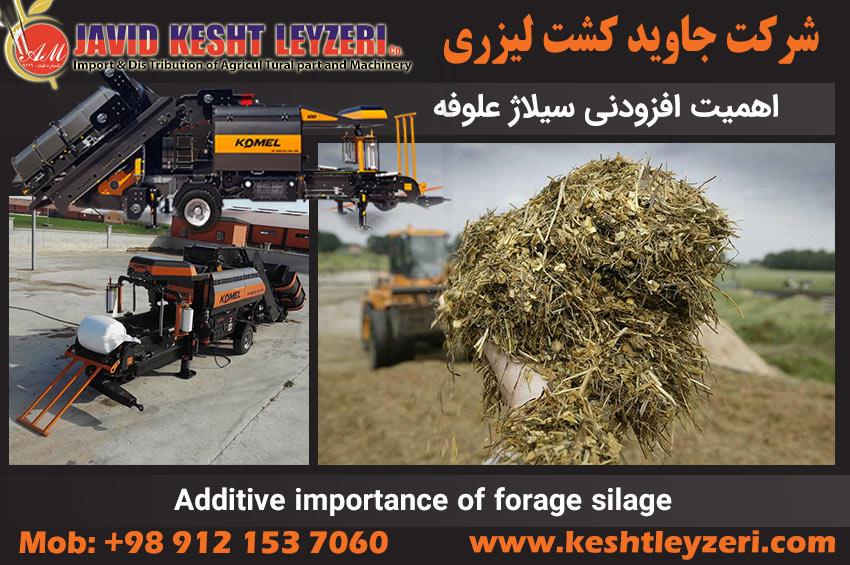
Additive importance of forage silage
javid keshtleyzeri Co.ltd
Corn silage additives do not have the ability to turn bad silage into good silage, they can only turn good silage into great silage.
Based on this, it is not possible to expect green bulk fodder corn that has been on the road from Dezful to Tehran for 18 hours and maybe more, and almost all its sugar and protein have been decomposed and destroyed, and all the local dust that contains clostridia spores. Also on its leaves, we can improve it only by adding a biological additive.
In many cases, following the basic principles of silage is preferable to using any silage additives. While in traditional silos, when fermentation is done in a non-scientific way and there is not enough pounding and proper packaging for the silo, how can we expect biological additives to give results?
Therefore, before deciding on the use of additives, make sure that the basic principles of ensiling are implemented well. In such a situation, we can go for biological additives. When buying a biological additive, some points should be considered. First, a good biological additive should contain at least three types of bacteria:
1) Starters, which are usually enterococci or pediococcus. This group of bacteria preserves silage protein against clostridia contamination by rapidly reducing pH from 7 to 4 within 48 hours.
2) Homofermentative bacteria, which are usually Lactobacillus bacteria and usually Plantarium strain, these bacteria can convert soluble sugars into lactic acid, which is considered the main mechanism in silage.
3) Heterfermentative bacteria, which is one of the commercialized bacteria Lactobacillus brevis, Lactobacillus kefiri, or Lactobacillus buchneri, which can convert part of the lactic acid in the silage into acetic acid, which is important in maintaining the aerobic stability of the silage. has it.
The importance of using silage additives
Silage biological additives have been used for the following reasons and are common in the market:
- Positive effect on accelerating fermentation and improving aerobic stability.
- More retention of dry matter and energy content compared to untreated silages.
- Security during the period of use and relatively lower cost per ton of silage treated compared to acids.
Regarding the additive quality of biological silage, it is possible to decide based on the strains and their ratio in the product. Multi-strain additives have the advantage of using different sources of energy, and each strain can have different desirable effects (quick pH reduction, more lactic acid production or acetic acid production for better aerobic stability). Therefore, it is possible to change the mechanism of effect of products There are several strains with the ratio of bacterial strains. On the other hand, different types of microorganisms in substrates, different temperature conditions and moisture content (osmotic tolerance), will have different growth rates. The number of bacteria in the product and the amount of use of the product depend on per gram will also determine the fermentation conditions.
It's not strange...!
Some friends who prepare silage in the traditional way admit that the biological additive of silage has not affected the quality of their silage...!
Why ?
Because it is very likely that they use biological additives that do not have the total of all three categories of bacteria.
In the same way, when we empty a load of bad soybean meal in the warehouse and consequently reduce production, we do not issue a verdict that soybean meal is an unsuitable food, regarding additives that require additional technical knowledge, we should also Let's comment more cautiously. The second thing that should be paid attention to when buying a biological additive is the correct amount of bacterial content added to fodder corn.
According to the proposal of the National Agricultural Society of the United States, each gram of silage should be loaded with at least one hundred thousand bacterial counts. Note that this amount is for fodder corn that does not have dust on it, in the case of contamination, double the amount of Kant. In fact, in such a situation, you send a stronger army against the clostridia. Therefore, according to the dose suggested by the company and its bacterial content, calculate whether the suggested dose can introduce one hundred thousand bacteria per gram of my silage?
In the current economic conditions, corn silage is the most important food item, and any mistake in our management behavior can lead to an irreparable disaster.
In a situation where the price of each percentage of protein is calculated at 30 Tomans, maintaining the maximum protein of corn silage can help the herd economically.
An important part of silage weight loss (=up to ten percent) is done through heat. A good silage is a cool silage. Therefore, the art of maintaining the aerobic stability of silage (=time from the opening of the silage, when its temperature increases by one degree Celsius) can help the herd economically. To achieve this result, the ratio of lactic acid to acetic acid should be 3 to 1. In such conditions, yeasts and molds cannot grow on silage exposed to air.
Table of nutrient requirements of rams during the lactation season

Recommended ration

Nutrition in storage and dry state
After the mating period, the ewes are fed in maintenance mode until the third of the end of pregnancy and then they receive pregnancy ration, so that their nutritional score at the time of delivery is between 3.3 and 3.5. (Feeding in order to use compensatory growth of the fetus is common in some units).
Table of nutrient requirements of sheep and ram in dry state

Recommended ration

Table of nutrient requirements of lactating goats

Suggested sources of supply

Table of nutrient requirements of sheep during flushing and mating

Recommended ration







